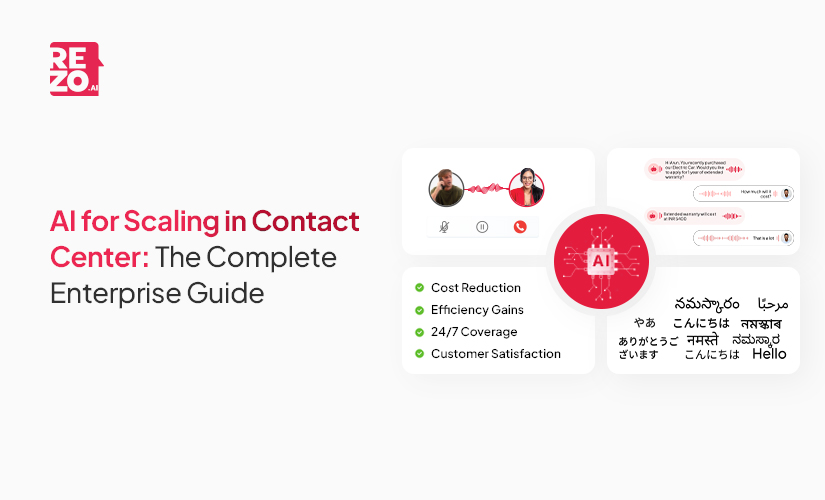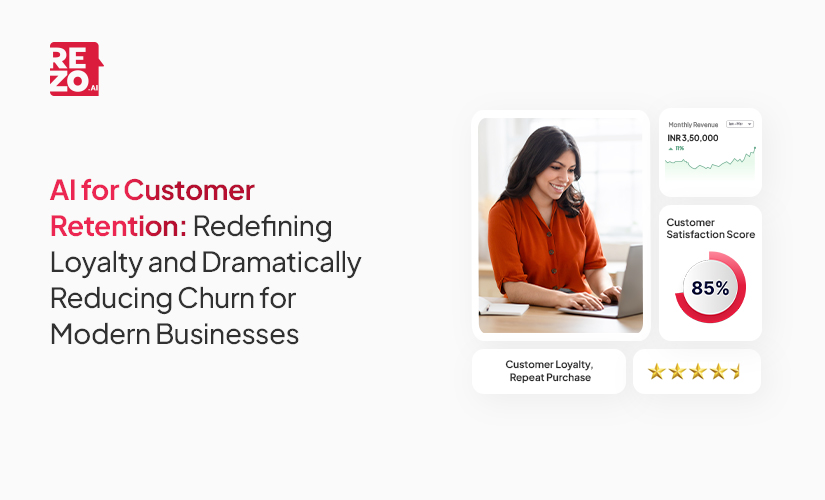
Delivering Hyper-personalization at Scale with Agentic AI

Delivering Hyper-personalization at Scale with Agentic AI

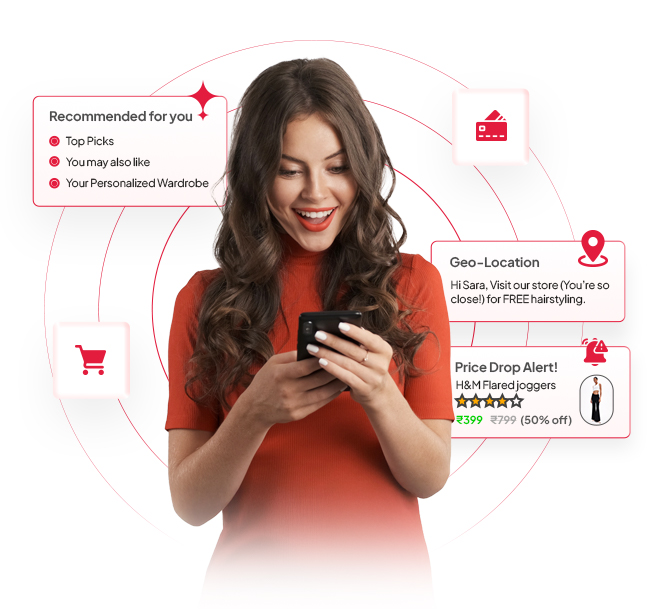
"Get closer than ever to your customers. So close that you tell them what they need well before they realize it themselves"
- Steve Jobs
For years, delivering personalized customer experience was a manual process dependent on agents performing a series of time-consuming tasks which was limited by rigid rules and fixed customer segments. Creating a unique interactions with customers often drained resources, making it difficult to move beyond static journeys to connect with customers.
But what if your customer experience could intelligently adapt to each individual’s needs, every time?
This transformation is already happening. Agentic AI is revolutionizing how enterprises approach customer experience, making hyper-personalization practical for organizations of any size.
In this blog, we'll explore how this technology works, why it represents a fundamental shift from traditional approaches, and what it means for enterprise leaders.
What is Hyper-personalization?

For a CX leader who understands the value of customer-centricity, hyper-personalization is more than just another trendy word that floats around boardrooms.
Hyper-personalization is an advanced marketing strategy that uses artificial intelligence, machine learning, and real-time data to deliver highly individualized experiences to each customer. This approach leverages real-time data, AI, and machine learning to create highly tailored customer experiences across various touchpoints to deliver personalized engagement.
It means leveraging AI and real-time data to deliver a hyper personalized experience so relevant and timely that every customer feels uniquely recognized and valued, at every touchpoint.
Tailored experiences are now expected by 71% of consumers, and businesses that deliver exceptional personalization see a 40% higher revenue from these efforts compared to their competitors. (McKinsey)
Agentic AI powered Hyper-personalization Workflow
Hyper-personalized customer journeys powered by Agentic AI represents a sophisticated ecosystem of interconnected components that work autonomously to deliver individualized customer experiences at scale. Understanding the core components and their workflow is essential for implementing effective hyper-personalization strategies that go beyond traditional rule-based systems.
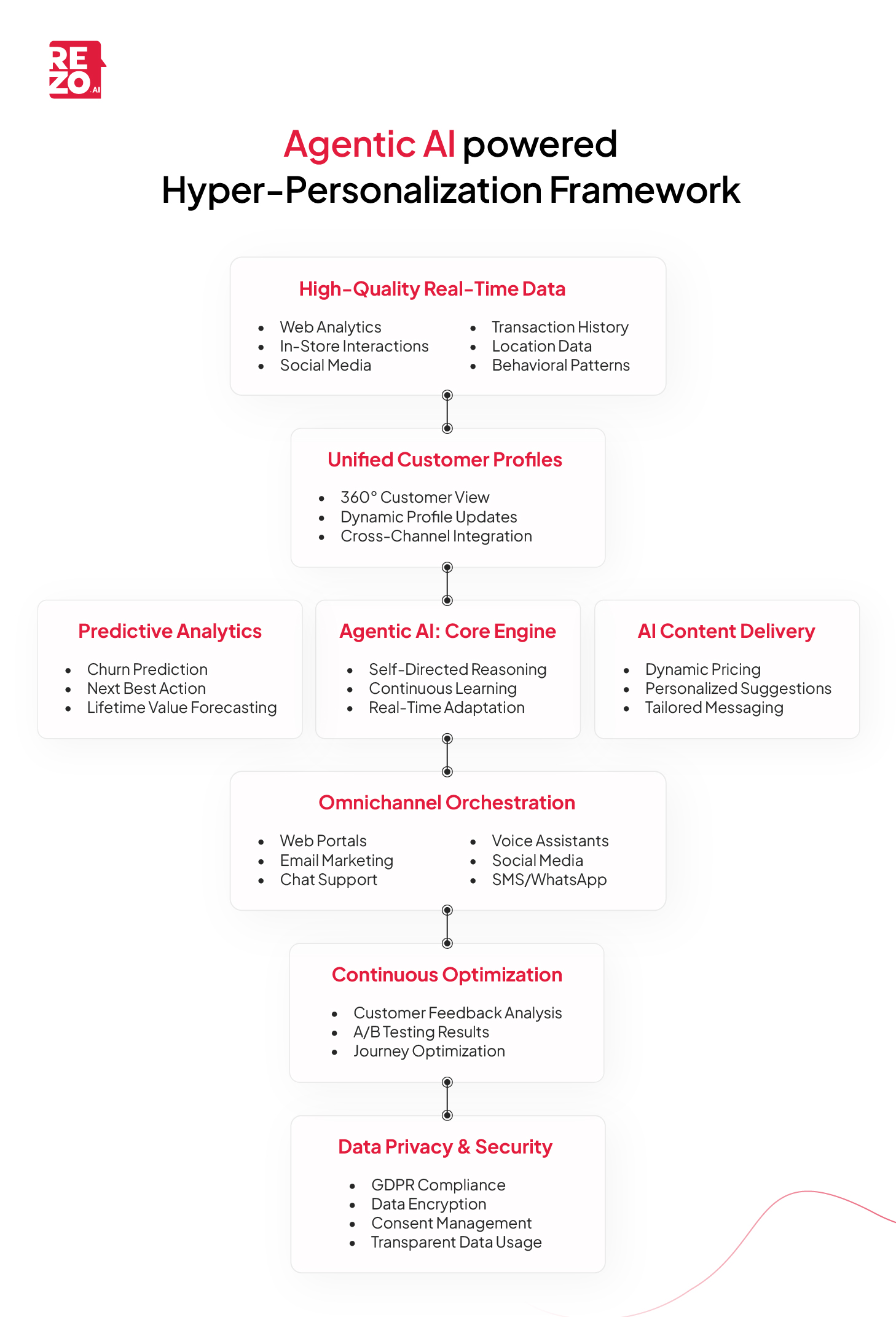
1. High-Quality, Real-Time Customer Data
- Hyper-personalization relies on continuous data collection and analysis of customer interactions across all customer touchpoints: web, mobile, in-store, and social channels.
- Real-time data usage ensures every interaction reflects the customer’s current needs and preferences, not just past behaviors.
2. Unified Customer Profiles
- All data points are integrated to create a single, dynamic view of each customer.
- This unified profile enables brands to tailor messaging and offers across the entire customer journey, supporting consistent, hyper-personalized interactions.
3. Agentic AI: The Brain Behind Hyper-Personalized Experiences
- With self-directed reasoning and learning capabilities, agentic AI interprets massive volumes of customer data, predict future behaviors and needs and adapt experiences in real time.
- These personalization engines use these insights to deliver dynamic pricing strategies, personalized rewards, and tailored messaging in real time.
4. Predictive Analytics with Agentic AI
- Agentic AI-driven predictive analytics anticipate customer needs and intent, empowering brands to proactively engage and deliver hyper-personalized offers often before the customer even articulates a need.
- This includes autonomously predicting product preferences, determining the optimal timing for outreach, and identifying potential churn risk, allowing for timely and effective customer engagement.
5. Contextual and Behavioral Data Integration
- Hyper-personalization strategies incorporate not just static data (like demographics, past purchases etc.), but also contextual data such as current location, device, weather, location data, and real-time behavior.
- This ensures offers and content are always relevant to the customer’s immediate context. For example, dynamic web pages can be personalized based on the customer's location, such as displaying travel deals or hotel recommendations tailored to the user's geographic area.
6. Omnichannel Orchestration
- Hyper-personalization delivers a seamless customer experience across all channels: web, app, email, chat, and in-store, ensuring continuity and consistency in personalized interactions.
- Every touchpoint is informed by the same unified customer profile.
7. Automation and Dynamic Content Delivery
- Automated systems dynamically adjust content, offers, and recommendations based on live customer data and interaction history.
- This enables brands to deliver highly relevant, personalized experiences at scale.
8. Customer Feedback and Continuous Optimization
- Hyper-personalization efforts are refined through ongoing analysis of customer feedback, user behavior, and engagement metrics.
- Feedback loops and A/B testing help optimize strategies, ensuring hyper-personalized experiences continue to improve over time.
9. Data Privacy and Security
- Robust security measures and transparent usage of data policies are essential to build trust and meet regulatory requirements.
- Customers are increasingly aware of how their data is used, so prioritizing data privacy is a key best practice.
Hyper-personalization vs Traditional personalization: What Sets Them Apart?
Hyper-personalization is an advanced approach to customer experience that uses real-time data, artificial intelligence, machine learning, and analytics to deliver highly individualized and contextually relevant experiences, products, or services for each customer.
Unlike traditional personalization, which might simply address customers by name or recommend products based on past purchases, hyper-personalization leverages a much broader and deeper set of data points.
Let's see the key difference between traditional and hyper-personalization:
In summary, while personalization improves relevance by using past data for customer segments, hyper-personalization takes it further by using real-time, granular insights to deliver experiences that feel uniquely crafted for each individual at every touchpoint and in every moment.
Benefits of Having a Hyper-personalization Approach
Hyper personalization enables brands to anticipate customer needs, providing timely offers and solutions that enhances user experience and drive repeat engagement. This approach also helps reduce customer acquisition costs by targeting the right set of audience with precision, while providing valuable insights into customer behavior and preferences allowing continuous refinement of marketing strategies.
Adopting hyper-personalization for customer experince offers a range of strategic and measurable advantages for businesses and their customers:
- Contextual Recommendations: Provides suggestions and offers that are highly relevant to the customer’s current context, boosting conversion rates and overall experience.
- One-to-One Personalization: Moves beyond segments to deliver individualized messaging and offers, nurturing stronger relationships and loyalty. Companies that excel at personalization can generate 40% more revenue from those activities than average players.
- Customer Journey Optimization: Continuously refines and enhances the entire customer journey, ensuring seamless, consistent, and satisfying experiences across all channels.
- Increased Engagement and Conversion: By presenting highly relevant content, offers, and recommendations, businesses can capture relevant attention, drive higher engagement, and improve conversion rates.
- Improved Customer Loyalty and Retention: When customers consistently receive experiences that reflect their unique preferences, they are more likely to return and build long-term relationships with the brand.
- Boosted Revenue and ROI: Hyper-personalization can directly impact the bottom line. Personalized experiences can reduce acquisition costs by up to 50% and increase marketing ROI by 10–30%.
- Operational Efficiency: Automation and AI-driven insights reduce the manual effort required to deliver personalized experiences, making operations more efficient and scalable.
- Omnichannel Consistency: Enables brands to deliver consistent personalized support across all channels, integrating online and offline interactions to provide seamless, unified experiences that strengthen customer relationships.
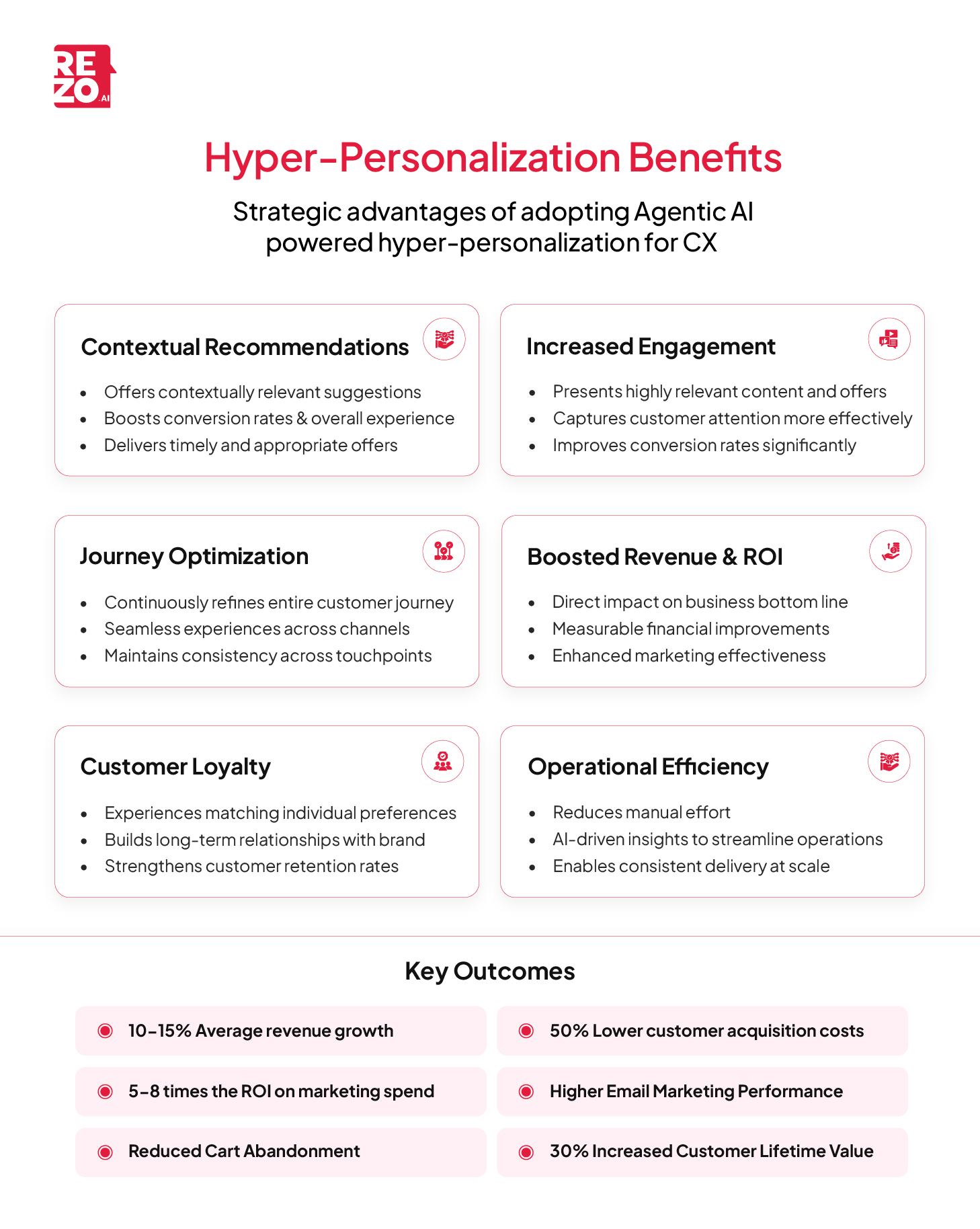
The Agentic AI Advantage: Achieving Hyper-personalization at Scale
Agentic AI is redefining what’s possible in customer experience by enabling one-to-one personalization at scale that traditional methods simply can’t achieve. By enabling AI agents to handle routine customer support tasks, businesses can support and enhance human roles, allowing human agents to focus on more complex and sensitive interactions.
Unlike older approaches that rely on broad segments or static rules, agentic AI autonomously analyzes vast amounts of real-time data, learns from every customer interaction, and adapts instantly to deliver experiences tailored to each individual. For example, agentic AI can automate workflows related to payment method updates or billing inquiries, streamlining operational efficiency and proactively resolving customer issues.
How Agentic AI Powers Hyper-personalization at Scale?
- Autonomous Decision-Making: Agentic AI leverages Autonomous Agents and Decision-Making AI to not only automate tasks but also independently make decisions, proactively anticipating customer needs and adapting to their changing preferences in real time.
- Continuous Learning: These AI Agents evolve with every interaction, using Adaptive Learning, advanced machine learning, and behavioral analytics to refine their understanding of each customer.
- Scalability: Multi-Agent Systems enable Agentic AI to manage millions of unique customer journeys simultaneously something that would require hundreds of human marketers working around the clock if done manually.
- Real-time Personalization: Through AI Orchestration, Agentic AI delivers dynamic product recommendations, context-aware support, and tailored messaging across channels, ensuring every touchpoint feels relevant and timely.
- Operational Efficiency: By automating routine interactions and optimizing campaigns on the fly, Goal-Oriented AI and Agentic AI free up human teams to focus on strategic initiatives, driving both efficiency and effectiveness.
- Alignment with CX Strategy Shifts: Agentic AI enables organizations to evolve their personalization strategy in response to new data, shifting customer expectations, and changing business goals, ensuring continuous optimization and alignment with broader CX initiatives.
Implementing Agentic AI for Hyper-Personalized CX
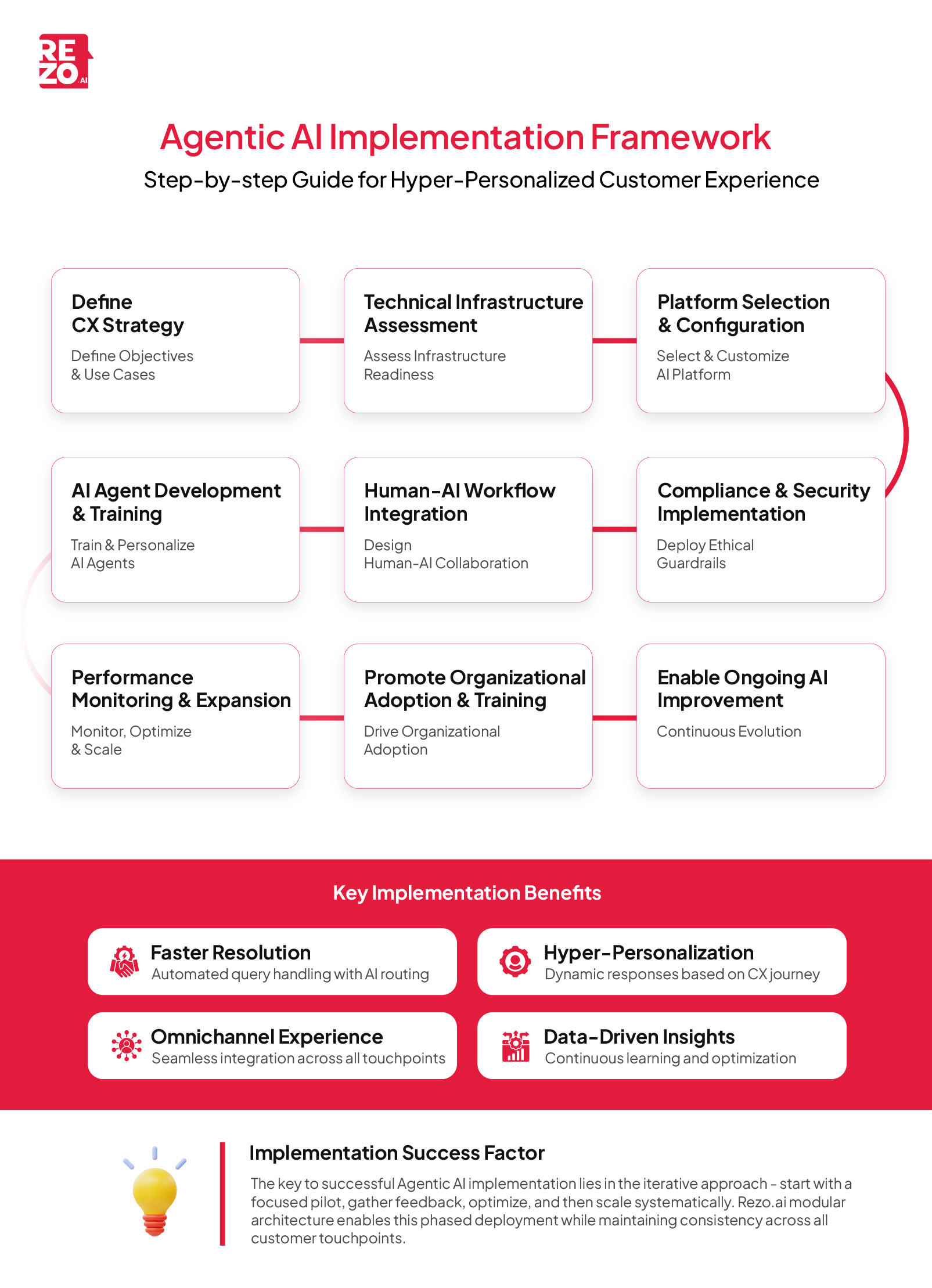
Here’s a step-by-step guide for implementing Agentic AI to achieve hyper-personalized customer experiences at scale, synthesized from industry best practices and implementation frameworks:
1. Define Objectives and Use Cases
- Identify key customer experience (CX) pain points and set measurable goals (e.g., faster query resolution, tailored recommendations).
- With Rezo, target high-impact use cases such as automating voice, chat, and email interactions, and providing hyper-personalized support across channels.
2. Assess Infrastructure Readiness
- Audit data ecosystems: Ensure access to real-time, high-quality customer data (e.g., past interactions, preferences).
- Rezo seamlessly integrates with existing CRM, ERP, and communication platforms (WhatsApp, Facebook, email, chatbots), ensuring smooth data flow and omnichannel orchestration.
- Agentic AI can also be integrated with supply chain management systems to automate inventory updates and inform customers about stock availability in real time.
3. Select and Customize AI Platform
- Choose a scalable framework: With Rezo's unified Agentic AI platform, you can leverage modular, plug-and-play AI elements that seamlessly adapt to any CX process.
- Train models with brand-specific data: Use curated datasets to align AI responses with company voice and values.
4. Train and Personalize AI Agents
- Launch controlled pilot: Use Rezo data-driven approach to analyze historical customer conversations, allowing the platform’s autonomous agents to learn intents, context, and optimal responses for your audience
- Implement feedback loops: Use session-level prompts (“Was this helpful?”) to refine accuracy.
5. Design Human-AI Collaboration
- Establish escalation protocols: Define triggers for human handoffs (e.g. complex complaints).
- Enable context preservation: Ensure seamless transition of interaction history during escalations.
6. Deploy Ethical Guardrails
- Embed compliance checks: Automate GDPR/CCPA adherence to data usage.
- Create audit trails: Maintain transparency in AI decision-making.
7. Monitor, Optimize, and Scale
- Monitor performance: Track metrics like personalization accuracy and resolution time via Rezo dashboards.
- Expand strategically: Roll out to new departments/geographies after validating ROI.
8. Drive Organizational Adoption
- Conduct role-based training: Teach agents delegation skills and managers oversight protocols.
9. Enable Continuous Evolution
- Retrain models quarterly: Incorporate new interaction data to refine personalization.
- Align with CX strategy shifts: Align AI capabilities with shifting CX strategies, leveraging Rezo.ai adaptive learning and modular architecture for ongoing innovation.
Key Implementation Insights:
- Data quality focus: 78% of hyper-personalization failures are due to poor data quality and siloed systems.
- Phased implementation: Organizations using phased AI rollouts achieve 3x faster time-to-value compared to “big bang” launches.
Measuring Success and ROI in Hyper-personalization
To ensure that hyper personalization efforts are delivering real value, it's crucial to measure their success and return on investment (ROI).
ROI Calculation Methods
Direct Revenue Attribution:
- Track revenue generated from personalized recommendations vs generic content.
- Calculate uplift in average order value (AOV) from personalized product suggestions.
- Measure incremental sales from targeted email campaigns vs mass campaigns.
Cost-Benefit Analysis:
- Compare personalization technology costs against increased conversion revenue.
- Factor in reduced customer acquisition costs due to improved retention.
- Account for operational savings from automated personalization vs. manual segmentation.
A/B Testing Framework:
- Split audiences between personalized and non-personalized experiences.
- Measure statistical significance in conversion rate improvements.
- Track long-term customer behavior changes, not just immediate conversions.
Predictive Analytics:
- Use machine learning to forecast customer lifetime value increases.
- Identify which personalization tactics drive highest ROI segments.
- Predict churn reduction rates from personalized engagement.
Real-World Example of Hyper-Personalization: Maruti Suzuki
Maruti Suzuki partnered with Rezo.ai to address a significant challenge: despite having nearly 90 lakh customers, their organized service centers were only capturing 1.5 years of an average 11-year service revenue opportunity per customer. This left a large gap in potential revenue.
How Hyper-Personalization Was Implemented
- Customized Offer Roll-outs: Outbound calls delivered tailored promotional and festival offers, qualifying leads and validating customer interest.
- Targeted Service Bookings: Personalized calls offered bundled deals and timely reminders based on each customer’s vehicle and service history, reducing funnel leakages.
- Upselling and Cross-Selling: Strategic outbound calls promoted warranty extensions and vehicle upgrades, presenting relevant offers based on customer profiles.
- Personalized Feedback Collection: Post-service survey calls gathered specific customer insights, enabling continuous improvement and rapid issue resolution.
Impact
- Service appointment bookings increased to 6 lakh per month.
- 8,500 leads generated daily.
- Operational costs reduced by 60%.
- Agent load reduced by 75%.
The Future of Hyper-personalization
The future of hyper personalization is being shaped by rapid advancements in AI and machine learning. As these technologies evolve, businesses will be able to anticipate customer needs with even greater accuracy, delivering personalized experiences in real time. The integration of natural language processing, predictive analytics, and large language models will enable brands to understand and respond to customer intent more intuitively than ever before. Looking ahead, the convergence of hyper personalization with emerging technologies like augmented reality and virtual reality promises to create immersive, interactive experiences that redefine customer engagement. As businesses continue to innovate, the ability to deliver highly relevant, hyper personalized experiences will become a key differentiator in meeting and exceeding customer expectations.
Conclusion
In summary, hyper personalization represents a transformative approach to customer experience, empowering businesses to deliver highly relevant and individualized interactions at every stage of the customer journey. By leveraging customer data, machine learning, AI and machine learning, and real time data, companies can drive customer satisfaction, foster customer loyalty, and achieve sustainable growth. As advanced technologies continue to evolve, it’s essential for businesses to prioritize data privacy, stay informed about the latest trends, and adopt best practices to deliver highly relevant and meaningful experiences. By doing so, brands can create meaningful connections, enhance customer loyalty, and secure a competitive edge in an increasingly personalized world.
Frequently Asked Questions (FAQ)
What Are the Challenges of Implementing Agentic AI Hyper-Personalization?
Agentic AI hyper-personalization faces four key challenges: Data privacy and compliance issues with GDPR/CCPA regulations and consumer privacy concerns; Poor data quality from fragmented or incomplete customer information; Algorithmic bias risks that can lead to unfair targeting and transparency issues; and Skills gap challenges due to shortage of AI expertise and change management capabilities within organizations.
What is the role of the Orchestration Layer in agentic AI architecture?
The Orchestration Layer serves as the intelligent coordination hub that manages resource allocation and workflow coordination across all system components. It handles complex AI task sequences, dependencies, and automated scaling to ensure optimal performance and seamless operations as demand fluctuates.
Frequently Asked Questions (FAQs)

Take the leap towards innovation with Rezo.ai
Get started now







